Robin Luo
Outlier-Efficient Hopfield Layers for Large Transformer-Based Models
Apr 04, 2024



Abstract:We introduce an Outlier-Efficient Modern Hopfield Model (termed $\mathtt{OutEffHop}$) and use it to address the outlier-induced challenge of quantizing gigantic transformer-based models. Our main contribution is a novel associative memory model facilitating \textit{outlier-efficient} associative memory retrievals. Interestingly, this memory model manifests a model-based interpretation of an outlier-efficient attention mechanism ($\text{Softmax}_1$): it is an approximation of the memory retrieval process of $\mathtt{OutEffHop}$. Methodologically, this allows us to debut novel outlier-efficient Hopfield layers a powerful attention alternative with superior post-quantization performance. Theoretically, the Outlier-Efficient Modern Hopfield Model retains and improves the desirable properties of the standard modern Hopfield models, including fixed point convergence and exponential storage capacity. Empirically, we demonstrate the proposed model's efficacy across large-scale transformer-based and Hopfield-based models (including BERT, OPT, ViT and STanHop-Net), benchmarking against state-of-the-art methods including $\mathtt{Clipped\_Softmax}$ and $\mathtt{Gated\_Attention}$. Notably, $\mathtt{OutEffHop}$ achieves on average $\sim$22+\% reductions in both average kurtosis and maximum infinity norm of model outputs accross 4 models.
How to Design Sample and Computationally Efficient VQA Models
Mar 22, 2021



Abstract:In multi-modal reasoning tasks, such as visual question answering (VQA), there have been many modeling and training paradigms tested. Previous models propose different methods for the vision and language tasks, but which ones perform the best while being sample and computationally efficient? Based on our experiments, we find that representing the text as probabilistic programs and images as object-level scene graphs best satisfy these desiderata. We extend existing models to leverage these soft programs and scene graphs to train on question answer pairs in an end-to-end manner. Empirical results demonstrate that this differentiable end-to-end program executor is able to maintain state-of-the-art accuracy while being sample and computationally efficient.
 Add to Chrome
Add to Chrome Add to Firefox
Add to Firefox Add to Edge
Add to Edge